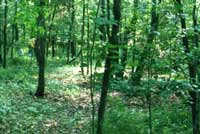DACF Home → Bureaus → Division of Animal and Plant Health → Integrated Pest Management → Teaching IPM in the Classroom → Environment and Ecology Lessons → Elementary School
 Teaching Integrated Pest Management in the Classroom—Environment and Ecology Lessons
Teaching Integrated Pest Management in the Classroom—Environment and Ecology Lessons
Elementary School Environment and Ecology Lessons
The following IPM lessons are based on environmental and ecology concepts. Most lessons are in PDF form.
K-1
- Leaves, Legs, or Neither (Differentiating between plants and animals)
cards
- Sharing the Planet (Humans roles as earth’s caretakers)
puzzle
- Staying Alive (Prey adaptations to avoid predators)
cards
- People Need Plants (Plant parts and the importance of plants in out diet)
cards handout
- Some Seeds Grow Weeds (Weeds vs other plants, plant life cycles)
cards handout
- Merrily We Move Along (Plant growth and methods of seed travel)
handout
- The Good, the Bad, and the Ugly (Importance of insects on earth and harmful/helpful insects for the environment)
cards board
- Ladybugs to the Rescue (Insect body parts, predator/prey relationships and diversity of life on earth)
poster
2-3
- Safety in Numbers (Biodiversity, relative populations of various plant and animal groups and cause and effect of current extinction pattern)
cards handout overhead1 overhead2
- Let the Sun Shine In (Sunlight importance for plants, green plants importance for other living things)
handout
- Weed Wise (Weed survival and weed's role in the environment)
- Nature's Bug Zappers (Nature provides natural predators to control over population)
card handout overhead
- Bug Busters (Bats help control insect populations and food chains)
handout overhead1 overhead2
- If You Can't Run, Hide! (Predator/prey relationships and pray hiding techniques)
handout
- Danger, Destruction Zone (Wetland ecosystems and negative effects of chemicals)
cards
4-5
- Everybody is Somebody’s Lunch (Connections between living things, food webs and chains)
lesson overhead handout1 answerkey1 handout2 answerkey2 cards1 cards2
- Extreme Makeover (Life cycles, life stages, life spans)
lesson handout answerkey assessment cards
- Flag on the Playing Field (Pred/prey relationships, prey avoidance behavior, biological controls)
lesson handout
- Planet of Plants (Interdependency of plants and animals, plant diversity in many environments)
lesson overhead handout1 handout2 cards assessment
- Presto, Chango (Process of photosynthesis, importance of green plants for other living things food source)
lesson handout1 asnwerkey1 handout2 answerkey2 handout3 answerkey3
- Six Bugs You’ll Learn to Love (Beneficial insects, human views of insects)
lesson handout1 handout2 handout3 answerkey3 cards
- Butterflies, Mealworms and Beetlemania (Metamorphosis, butterflies and mealworms, connections to using beetles as biological control agent for purple loosestrife)
lesson handout1 handout2 handout3 supplement1 supplement2 assessment cards
- DDT – Doing Deadly Things (Impact of chemical pesticides in an ecosystem)
lesson handout1 handout2 handout3 handout4 cards assessment1 assessment2
- Of Loraxes and Wumps (Studying pollution through fiction and experimentation)
pdlesson handout1 handout2 handout3
- The Choice is Yours (Environmental problems that impact people, plants and wildlife; “ecological footprints”; behavioral changes to reduce impact on the environment)
lesson handout assessment1 assessment2 assessment3
Pennsylvania State University Elementary Integrated Pest Management Lessons
- Create a Soil Aggregate (Explain and visualize the many organisms in the soil and how they contribute to the soil structure)
- Food Chains Are Not a Necklace! (Food chains)
- Life Cycles: A Never-Ending Story ( Life cycles for butterflies, frogs and white-tailed deer)
- Organic/ Regenerative Farming vs. Conventional Farming (Reducing pesticide use with other methods of farming)
- Weeds- Wild and Wonderful (“weeds” that were commonly used by our ancestors)
- View all Pennsylvania State University Elementary IPM Lessons here
Michigan State University Elementary Urban IPM Curriculum
- Activity 2: Create an Animal (Explores roles and components of habitats)
- Activity 4: In Search of Life (Students explore the school to find living things and categorize them into groups)
- Activity 10: All About Rodents (Life cycles, habitats, etc. that make rodents pests)
- View all Michigan State University Elementary IPM Lessons here
Iowa State University IPM Pilot Program
- (K-2) Arthropods at Home: Spider, Isopod or any Arthropod (Arthropod habitat needs)
- (K-2) Little Me in a Big World: Ants (Life of ants, how they overcome obstacles)
- (3-4) Habitat Breakdown (Organisms, habitats and habitat elements)
- (3-4) Web of Life (organisms and ecosystem connections)
- (5-6) Beautiful Butterflies – Activity Centers (Habitats, ecosystems, organism modifications, and organisms survival techniques)
- (5-6) The Sweet Connection (Bee and plant relationships)
- View all Iowa State University Elementary IPM Lessons here
Cornell University, New York State Integrated Pest Management Program: Teaching IPM
Browse the list below to find lessons of interest and then find the corresponding lesson on the host website above.
- Green Science: Composting for Better Soil (Teach students all about composting and start your own composting project at your school)
- Green Science: Experiment #1- Sun, Water or Both? (Experiment with plant requirements for growth)
- Green Science: Experiment #2- Bean Sprouts (Experiment with plant requirements for growth)
- Green Science: What do Plants Need for Growth? (Plant growth requirements)
- Land: Earthworms on the Job (Earthworm biology)
- Land: Erosion (Soil erosion)
- Land: Soil is Important (Soil ecology)
- Land: Taking Care of the Land (Maintaining soils for agriculture)
- Land: Water Quality (Water cycles, water quality)
- Land: What is Soil? (Basics on soil)
- Land: What’s in soil, anyways? (Soil ecology)
- Land: What’s Living in my soil? (Soil ecology)
- Plant Science: Grow an Indoor Salad Garden (Comparing indoor and outdoor plant requirements)
- Plant Science: Photosynthesis (Plant anatomy and Photosynthesis)
- Plant Science: Plants as Living Things (All about plants)

[Photo: (hardwood stand) Brian Lockhart, Bugwood.org]